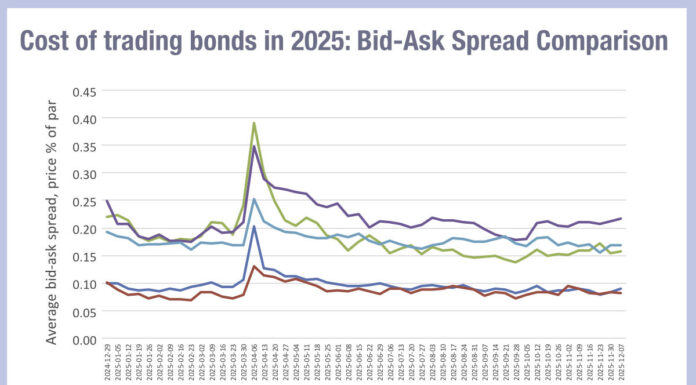Minutes of the 31 March meeting of the Federal Reserve’s Treasury Market Practices Group (TMPG), including an update on a 19 March call between members, has highlighted the stresses the market was under that month, including a note that mortgage-backed securities liquidity was worse than in the 2008 credit crisis.
In light of the extraordinary market volatility amid the coronavirus pandemic during the middle of the March, the TMPG held the intermeeting call on 19 March 2020 to discuss market functioning.
Overall, its members noted that were was “significant market functioning issues across TMPG-covered markets” in recent weeks, which included severely strained liquidity amid unprecedented levels of market volatility.
Members also described the array of Open Market Operations by The Desk – The Fed’s trading desk – as helpful and impactful, but encouraged “further and more dramatic measures.”
Concern about the credit markets was expressed particularly with members noting that additional support or action would be needed. In funding markets members observed “significant deteriorations in money market functioning” in the recent period most notably in commercial paper, where liquidity and balance sheet availability had become difficult to source.
In the US Treasury markets the group’s members noted exceptionally wide bid-ask spreads and expressed difficulty in executing transactions or finding liquidity in Treasury markets. Members also pointed to the widening in the cash-futures basis and many investors looking to raise cash, which resulted in a wave of selling as hampering liquidity even further. Liquidity was described as being particularly poor in the Treasury Inflation-Protected Security (TIPS) markets and at the long-end of the curve.
Members described mortgage market functioning as “severely poor”, with liquidity being as bad or worse than in the 2008 credit crisis which had been triggered by mortgage-backed securities. The pace and scope of the deterioration in markets were cited as “amplifying leverage ratios for levered accounts who needed to sell in order to de-lever and meet margin calls.”
The deleveraging was then cited as resulting in a secondary market supply shock, which came on top of a week of heavy supply from the primary market from a historically large refinancing wave.
The call concluded with a discussion on contingency and resiliency efforts with a few concerns raised about breakdowns in communication and the ability of traders to execute given the work from home environment, which could be exacerbated as more employees move to a work from home posture.
In the 31 March meeting, members broadly noted that funding conditions have improved and that markets had stabilised near the zero lower bound, although some strains were still evident in term funding markets.
The Primary Dealer Credit Facility (PDCF) and Money Market Mutual Fund Liquidity Facility (MMLF) were welcomed. Members highlighted that excess cash remains in the system, contributing to large inflows into government money funds. It was also noted that these flows can be viewed as structural as investors shift into cash to reduce risk profiles.
While members noted that liquidity metrics across the curve, including market depth and bid/ask spreads, had continued to normalise by the end of March, relative to recent weeks, the recovery was not complete and it varied across instruments.
The long end of the nominal curve was said to have lagged behind the rest in terms of liquidity. Fed intervention in the agency MBS market had led to improved liquidity and had reduced the spread between agency MBS and Treasury hedge equivalents, but members noted that the tightening of the mortgage basis was having an adverse impact in the primary mortgage market.
With the fall in broader interest rates and tighter spreads, members noted that “the significant rise in the price of agency MBS TBA contracts were leading to margin calls on mortgage originators who have sold these contracts as a hedge against new mortgage origination.” Members also noted that “there were likely to be delays in the closing of mortgage loans stemming from the coronavirus which would not only impact the timing of cash flows for mortgage originators, but also complicate prepayment and other risk modeling for agency MBS.”
While TMPG members described liquidity and access to credit markets for investment grade issuers as improving, the market for less highly-rated corporate debt issuers was said to have remained strained. Members noted that Fed support of this market helped improve liquidity and reduce corporate risk premium before the programmes were live.
Overall, contingency and resiliency arrangements were said to have worked well. Minutes for the latest interim call on 19 April and the most recent meeting on 12 May have not yet been released.
©Markets Media Europe 2025













